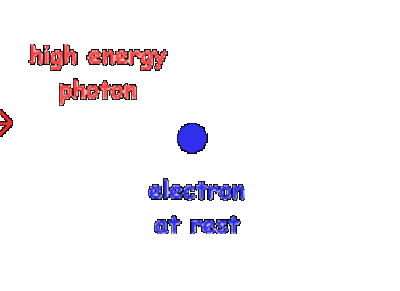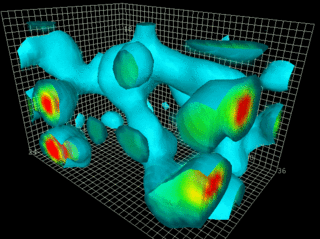
Is it sand running through our fingers, or a taffy like substance, in symbolic form?
The difference, discretium and fluidity of nature, geometrically/topologically driven, are at war with what we might interpret in time? Early on, Salvador Dali understood well this geometrical propensity to the tesserack, that he embued his art with higher religious context(time). But in real life, he was different man?:)
The issues were not far removed from perspective, that this battle would find itself challenged, in how we would portray the nature of reality? That it had burst forth in science and it's manifestations.
But come back to earth, and we have to wonder indeed if this fluid is slipping through our fingers as time reveals a more intrinistic view of the reality in the cosmos?
 Sean Carroll said
Sean Carroll said:
Friedmann fights back:For those of you interested in the attempt by Kolb, Matarrese, Notari, and Riotto to do away with dark energy, some enterprising young cosmologists (not me, I'm too old to move that quickly) have cranked through the equations and come out defending the conventional wisdom. Three papers in particular seem interesting:
Lubos Motl:
Superhorizon fluctuations and accelerating Universe:Several physicists and bloggers, e.g. Jacques Distler, Peter Woit and especially Sean Carroll who may be considered a true expert in these questions and who added a very new article after this article of mine was published, recently noticed a paper that claimed that the cosmological constant was not needed. Instead, the accelerating expansion was conjectured to be a consequence of fluctuations of a scalar field (and the associated stress energy tensor) whose wavelength was longer than the Hubble radius i.e. the size of the visible Universe, roughly speaking.
I agree with Lubos here in regards to what has already been establish to date in the positions. Here with
Sean Carroll,
Jacques Distler,
Peter Woit, and Lubos Motl respectively, that they all agree on the standards set here?
This would be a clear statement of position, and one that would signal, accepted practice on the expository view of our cosmos? Is it to ambitious?
Out of this a standard, even if there are divergences of personality; this is wiped away, so that we are introduced to new information as Sean shows us withRaychaudhuri equation? This gives one direction to look at.
This equation has the special characteristic that it is true without reference to the Einstein equations . That is, it is true for any spacetime. It is an intrinsic property of  the volume expansion.
the volume expansion. Now we come back to the intuitive development from this standard presence. Would it be so wrong to ask that four minds to stand together and paper their perspective? Then open it up to geometry/topological views, in relation to how we might develop the imagery of what might have been gathered from the dynamical realization of early universe idealizations?

In regards to the tactile experience one might want to comprehend is in the way the universe now has unfolded?
Now there is a most definite need to grasp the issue here in terms of what causality might mean in terms of balckhole/3 brane collapse as a perspective to the dynamics that would be revealled, for photon,/graviton production from the blackhole?
Using Calorimeter, we see where such advances help us to distinquish early universe information in Glast cosiderations, but how much more suttle has this experience need to be expanded upon, to understand the exchange that takes place in the gravitational collapse?
John Baez:
Now, the way Hawking likes to calculate things in this sort of problem is using a "Euclidean path integral". This is a rather controversial approach - hence his grin when he said it's the "only sane way" to do these calculations - but let's not worry about that. Suffice it to say that we replace the time variable "t" in all our calculations by "it", do a bunch of calculations, and then replace "it" by "T" again at the end. This trick is called "Wick rotation". In the middle of this process, we hope all our formulas involving the geometry of 4d spacetime have magically become formulas involving the geometry of 4d space. The answers to physical questions are then expressed as integrals over all geometries of 4d space that satisfy some conditions depending on the problem we're studying. This integral over geometries also includes a sum over topologies.
That's what Hawking means by this:
Stephen Hawking:I adopt the Euclidean approach, the only sane way to do quantum gravity non-perturbatively. In this, the time evolution of an initial state is given by a path integral over all positive definite metrics that go between two surfaces that are a distance T apart at infinity. One then Wick rotates the time interval, T, to the Lorentzian. The path integral is taken over metrics of all possible topologies that fit in between the surfaces.
How would missing energy events isolate the realization that such ventures would have been specific in detailing the envelope capturing all that has evolved in our universe to know that there is this consistancy, that spreads itself through all possibiltyies of Feynman's sum over paths of expression, that still needs to be identified?
Now you must know that there are consequences when we see this collapse take place that asks us to consider the nature of the temperatures and diameter in reduction?
That what has been reduced in this energy developing scenarion of the cosmos in action, is a applicable view to geometry/topology that at the same time reveals the idealization of entropic features of supersymmetical views that we learn to see?
How this experience, as tactile as I approach it, is induced, is at very illusatory experience way back in some speculative past.:)Whooh! What? Careful now, I am analogically speaking here, because I like to see this way. It feels right(not saying it is right) as simple statement quickly summing up many mathematical views in a very short and simple way. That's what I hope anyway.
When you look at this fluid geometrically/topolgically driven what view has transpired in blackhole production? You want to be able to understand the symmetrical breaking that is taking place? Crystalization processes, would quickly surmize a Laughlin view from a fast cooling temperature, to realize, it is much more slower then this in the cooling(15 bilion year assumption) in a cosmological process?
So we understand curvature is well aquainted with vast track of cosmological views, but it become much more diffiult at such microscopic thinking. Sort of, all smeared out in a vast supersymmetrical views of previous states of existance, that quickly gather to form maybe, cosmic strings?:)
John Baez said,
But you shouldn't imagine the mood as one of breathless anticipation. At least for the physicists present, a better description would be something like "skeptical curiosity". None of them seemed to believe that Hawking could suddenly shed new light on a problem that has been attacked from many angles for several decades. One reason is that Hawking's best work was done almost 30 years ago. A string theorist I know said that thanks to work relating anti-deSitter space and conformal field theory - the so-called "AdS-CFT" hypothesis - string theorists had become convinced that no information is lost by black holes. Thus, Hawking had been feeling strong pressure to fall in line and renounce his previous position, namely that information is lost. A talk announcing this would come as no big surprise.




